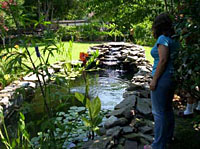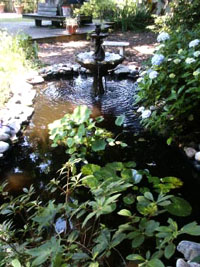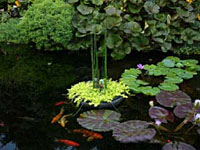Uncategorized
Components for a Low Maintenance Garden Pond
Components for a Low Maintenance Garden Pond
by Chris Deer
Many of you may be considering putting a garden pond or koi pond in your yard. The biggest mistake someone considering a garden pond makes is improper planning. A water garden, just like a landscape, requires some thinking and planning before making a purchase. Where is the proper location for a garden pond? What shape and size do I choose?
Koi require large, deep ponds to grow. Do I want a pond with colorful koi or do I just want to keep low maintenance common types of goldfish? What filtration components are required? What types of water garden plants do well in the climate and what type of care will they require? These are the questions I will answer for you here.
LOCATION: A garden pond should be placed in an area where it will receive at least 6 hours of sunlight per day. Water lilies, bog plants and lotus will refuse to bloom if these light requirements are not met. Though the plants will survive, under low light conditions, most aquatic plants that are available for water gardens will perform poorly. Placing a garden pond near or under the canopy of certain trees can become a maintenance nightmare. Live oaks, sycamores, pine trees, river birch and magnolias will all add to the amount of time you spend cleaning your pond instead of enjoying it. Choose an open area with plenty of sunshine for best results.
SIZE, SHAPE AND DESIGN: When designing your garden pond, choose a shape that will allow the filtration system to circulate the water in all areas of the pond. Circular, kidney shaped, rectangular and oval shaped ponds will reduce the amount of time you will have to spend dipping out leaves and other debris. To reduce the chances of your fish being a meal for water fowl like herons, dig the pond at least 24” deep. If a bird does come in for a quick meal, the fish can move into the deeper water for protection. If you are planning on keeping koi in your garden pond, dig the pond at least 36” deep. In order for koi to reach any size, plan on a pond of 3000 gallons or more.

Choose a shape that allows water to flow from one end to the other

Koi are often destructive to aquatic plants so plan an area of the water garden that can be separated just for placing water lilies and other aquatic plants. In smaller ponds, or those designed mainly for plants, goldfish varieties are available that will not harm your plants or outgrow your pond.In a pond with goldfish, the plants can be housed throughout keeping in mind the depth at which
the plants will be placed. Dig out shelves along the perimeter of the pond no deeper than 18” from the surface. Aquatic plants can be placed anywhere on the shelves where the water surface is calm. Many do well in floating islands.
The use ofFish Safe Pond Guard EPDM rubber liner material that is 45ml thick is one of the least expensive and versatile materials for lining the pond. Liners will conform to nearly any shape and are durable, lasting up to 20 years if cared for properly. The perimeter can be finished off using decorative rock for informal settings or brick if you have a more formal design. See liners.Avoid the plastic preformed ponds, they are too shallow and the plastic material tends to become brittle and crack with time.
FILTRATION COMPONENTS: The most important one of the most costly parts of a garden pond is the filtration system. Every pond should incorporate a surface skimmer, a mechanical filter, a biological filter, a chemical filter, an ultra violet clarifier and in some larger ponds, a bottom drain. You will also need a circulation pump that will turn over the volume of your garden pond at least once per hour. If you are incorporating a waterfall in your pond, a larger pump will be required to get the desired effect over the rock work. Here are the basics on the filtration components:


The surface skimmer attaches directly into the rubber liner of the pond. The skimmer draws water off the surface in order to catch leaves and other debris before it can settle on the bottom of the pond where you will have to remove it. Most skimmers incorporate a leaf catcher as well as a pad (a mechanical filter) for trapping finer debris. The water pump is often housed within the skimmer to protect the intake of the pump from becoming clogged with debris. Without a skimmer, the surface can become stagnant and you will spend many hours dipping out leaves and plant remnants. See Surface Skimmers.
The next component of the filtration system is the biological filter. It is crucial that a biological filter is used if you are keeping any fish in your garden pond. The purpose of the biological filter is to keep water parameters in check. Media like shredded PVC, ceramic or plastic rings and plastic ribbon offer surface area for beneficial bacteria to grow. These bacteria break down harmful ammonia and nitrite given off by the fish.
Biological media should allow for good water circulation to provide enough oxygen to the bacteria living on the media. Though a cheap biological media, lava rock quickly becomes inundated with pond debris and fish waste causing it to become clogged and void of oxygen. Deadly hydrogen sulfide can be produced in these dead zones and if disturbed, can be released into the pond water killing the fish. Whatever biological media you purchase, protect the beneficial bacteria by rinsing the media with either well water, pond water or dechlorinated tap water. Oase, and Aquarium Life Support Systems biological filters are unsurpassed.
To prevent pond water from becoming an ugly, thick pea soup green, the use of an ultra violet clarifier is a must. Inside the housing of an ultra violet clarifier is a germicidal UV lamp that kills free floating single celled algae thus keeping your pond water crystal clear. UV clarifiers are available in different wattages depending on the number of gallons in your pond and the flow rate of your water pump. We will assist you in determining the size UV suited for your pond. See UV Sterilizers.
With time, pond water will develop a yellow tint from fish waste and other dissolved organic materials in the pond. The use of a chemical media like activated carbon placed in a nylon bag in the filter will quickly remove these organics. Accumulated organics in the water will encourage problematic algae like blanket weed and string algae. These algae will clog filters and destroy the beauty of your pond so it is important for you to keep filter pads cleaned and debris that is not captured by the filter dipped out from the water. Activated carbon changed out every 2-3 months will also help in keeping organic levels low. See AquaLife Pelleted Carbon and AquaLife Scientific Grade Carbon.
In larger ponds or ponds that are extremely deep, the use of a bottom drain attached to a separate external pump will greatly reduce the maintenance. Bottom drains will draw in debris not captured by the skimmer and deposit it in a mechanical filter outside the pond. If you incorporate a bottom drain, install it in the lowest area of the pond where debris is likely to settle.
Now you have your filter components. The skimmer should be placed on one end of the pond. The water will be drawn into the skimmer, through the mechanical filter pads, through the chemical filter media via the water pump. From there the water should be circulated through the UV clarifier and lastly through the biological filter on the other end of the pond where the water will be returned. This will allow circulation through the entire water garden so that optimum filtration can be achieved. A good filtration system equals a low maintenance garden pond.
The liner and filtration are now in place. Fill the pond with water pulling out any wrinkles in the liner as it fills. Once filled, condition the water with AquaLife Complete.
PLANTS AND FISH: In a new pond, add only a small number of fish for the first 4-6 weeks of operation. Add AquaLife Water Garden Cleaner to seed the biological filter. This establishes the biological filter without overloading it and causing a large fish kill. It takes time for the beneficial bacteria to become established in the biological filter so have patience. Purchase inexpensive fish at first as this is the most stressful period for your pond inhabitants. This is also an excellent time to add your water garden plants. Not only will plants help in establishing the biological filter, they will also get a chance to become established before large numbers of fish are present offering the fish shade and protection from predators.
Water lilies should be placed no deeper than 24” in the pond in areas that are void of splashing water. Keep lilies away from fountains, waterfalls and the intake area of the skimmer. There are both hardy and tropical water lilies available. The hardy lilies ‘Charlene Strawn’ and ‘Denver’ handle the heat and will bloom from late spring until frost. If placed in very shallow water, hardy lilies will produce leaves both on the surface of the water as well as above the water making a showy display of both foliage and blooms. Hardy lilies are available in white, pink, red, orange and yellow.
The addition of tropical water lilies is a must! Though late to emerge, tropical lilies love the heat and the hotter it gets, the more blooms they produce. We suggest the cultivars ‘Leopardess’ and ‘Panama Pacific’. As the name implies, tropicals are more sensitive to winter damage and must be protected from frost. There are also night blooming tropicals available. These lilies produce huge blooms from June until October that open at dusk and close around mid morning. Night blooming lilies are the most sensitive to winter cold so they may require replacing if we have a severe season. Tropical lilies should be placed no deeper than 18” above the crown of the plant. If you enjoy colors of blue, purple, deep red and bright pink, include some tropical lilies in your pond.
There are so many incredible marginal plants available for water gardens. Marginal plants should be placed in water no deeper than 2”-3” above the top of the pot. Try these bog plants for their hardiness and beauty to the water garden:
Lotus – available in a number of colors and forms
Louisiana Iris – spring flowering only, often evergreen.
Colocasias – for larger ponds – great structure
Canna ‘Bengal Tiger’ – striking foliage all summer.
Hardy Cyperus – appeal in both summer and winter
Bog Crinums – delicate flowers over strapping foliage
Cattails – Typhas are hardy and interesting
Lastly, most water garden plants are potted in small 1 gallon pots when purchased. For best plant performance, repot aquatic plants in 3-5 gallon pots designed especially for water plants. Repot these plants in heavy soil designed specifically for garden ponds. Cover the soil of pond plants with large pea gravel to prevent fish from rooting out the soil. Water garden plants should be fertilized at least monthly throughout the growing season using fertilizer tablets developed specifically for pond plants. Regular pruning of spent blooms and old foliage will keep water garden plants beautiful from late spring until frost.
Take a step back and put together a budget that you can afford before you dig that huge hole in your backyard. There are filtration components available for nearly any budget but whatever you decide on, do it right the first time around so you will spend the majority of your time enjoying your pond. Like any hobby, it does require some regular maintenance but if you do it right, chances are you will be digging a larger pond in the near future!

